As one of the world’s largest and most popular cryptocurrency exchanges, Binance offers a wide array of trading services to its users, catering to both novice investors and seasoned traders. Central to the platform’s functionality is the concept of trading, which allows users to buy, sell, and exchange digital assets across various markets. In this article, we delve into the intricacies of trading on Binance, offering a comprehensive guide to help users navigate the platform’s trading features and maximize their investment opportunities.
Understanding Trading on Binance
Before diving into the specifics of trading on Binance, it’s essential to grasp the fundamental concepts and terminology associated with cryptocurrency trading:
Market Orders: A market order is an instruction to buy or sell a cryptocurrency at the current market price. Market orders are executed immediately, ensuring swift transaction completion but may be subject to price slippage in volatile market conditions.
Limit Orders:
A limit order allows users to specify the price at which they are willing to buy or sell a cryptocurrency. Limit orders are not executed immediately but are placed on the order book until the market reaches the specified price, providing users with more control over their trades.
Stop-Loss Orders:
A stop-loss order is a risk management tool that allows users to set a predetermined price at which their assets will be automatically sold to limit potential losses. Stop-loss orders help traders mitigate downside risk and protect their investment capital in volatile markets.
Trading Features on Binance
Binance offers a comprehensive suite of trading features designed to meet the diverse needs of its users:
Spot Trading:
Spot trading is the most common form of trading on Binance, allowing users to buy and sell cryptocurrencies directly from the exchange’s order book at the current market price. Binance supports a wide range of trading pairs, including fiat-to-crypto, crypto-to-crypto, and stablecoin pairs.
Futures Trading:
Binance Futures enables users to trade cryptocurrency derivatives contracts, including perpetual contracts and futures contracts with leverage. Futures trading allows traders to profit from both upward and downward price movements, amplifying potential gains but also increasing the risk of losses.
Margin Trading:
Binance Margin allows users to borrow funds to increase their trading position size, amplifying potential profits but also magnifying potential losses. Margin trading on Binance enables users to trade with leverage, using borrowed funds to increase their buying power and exposure to the market.
Tips for Successful Trading on Binance
To maximize your trading experience on Binance, consider the following tips:
Research and Analysis:
Conduct thorough research and analysis before making trading decisions. Stay informed about market trends, news events, and technical indicators to identify profitable trading opportunities.
Risk Management:
Implement risk management strategies such as stop-loss orders and position sizing to protect your capital and minimize potential losses. Only trade with funds that you can afford to lose and avoid over-leveraging your positions.
Diversification:
Diversify your trading portfolio by investing in a variety of cryptocurrencies and trading pairs. Avoid putting all your eggs in one basket and spread your risk across multiple assets to mitigate volatility and potential losses.
Conclusion:
In conclusion, trading on Binance offers users a wealth of opportunities to capitalize on the dynamic and rapidly evolving cryptocurrency markets. By understanding the fundamentals of trading, leveraging Binance’s diverse range of trading features, and implementing sound risk management practices, users can navigate the complexities of the market with confidence and maximize their investment potential. Whether you’re a novice investor or an experienced trader, Binance provides the tools and resources needed to succeed in the world of cryptocurrency trading.
Related posts:

















